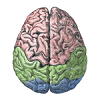9: Language
( \newcommand{\kernel}{\mathrm{null}\,}\)
- 9.2: Biology of Language
- The classic "textbook" brain areas for language are Broca's and Wernicke's areas, which have been associated with syntax and semantics, respectively. For example, a person who suffers a stroke or other form of damage to Wernicke's area can produce fluent, syntactically-correct speech, which is essentially devoid of meaning.
- 9.3: Reading and Dyslexia in the Triangle Model
- The first language model we explore simulates the major pathways involved in reading, according to the so-called triangle model. This model provides a basic understanding of the functional roles of visual perception of written words (orthography), spoken motor output of word phonology, and semantic representations of word meaning in between.
- 9.4: Spelling to Sound Mappings in Word Reading
- We now zoom in on the direct pathway between visual word inputs (orthography) and verbal speech output (phonology), using a much larger set of words comprising most of the monosyllabic words in English (nearly 3,000 words). By learning on such a large selection of words, sampled according to their frequency of occurrence in English, the network has a chance to extract the "rules" that govern the mapping between spelling and sound in English, and thus be able to successfully pronounce nonwords.


